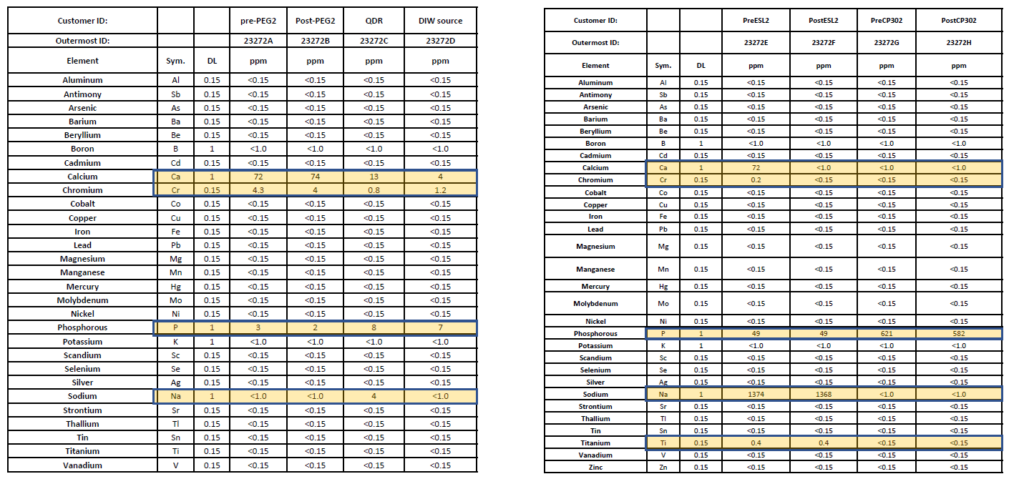 Induced Coupled Plasma – Mass Spectrometry (ICP-MS) & Optical Emission Spectroscopy (ICP-OES)
Induced Coupled Plasma – Mass Spectrometry (ICP-MS) & Optical Emission Spectroscopy (ICP-OES)
Overview
ICP analysis is a highly sophisticated and versatile technique that enables us to delve deep into the elemental composition of various substances. It operates by utilizing an Inductively Coupled Plasma source to ionize and atomize the elements present in a sample, transforming them into ions. This ionization process occurs at incredibly high temperatures, on the order of 10,000 degrees Celsius, within the ICP torch.
The magic happens when these ionized elements are introduced into a mass spectrometer (ICP-MS) or an optical emission spectrometer (ICP-OES). In ICP-MS, the ions are sorted by their mass-to-charge ratios, allowing for precise quantitative measurements of trace elements. In ICP-OES, the emitted light spectra from the ionized elements are analyzed, providing qualitative and quantitative elemental information.
ICP analysis is a vital tool for a wide range of applications, from environmental monitoring and pharmaceutical analysis to materials characterization and geological exploration. Its ability to provide accurate and sensitive multi-elemental analysis makes it indispensable in research, quality control, and regulatory compliance.
At Outermost Technology, our commitment to excellence ensures that you have access to the most advanced ICP analysis capabilities, delivering precise elemental information to drive your projects forward. Whether you are seeking to understand trace element concentrations, assess sample purity, or unravel the secrets hidden in complex matrices, our ICP analysis services are here to empower your analytical needs.
Services
- ICP-MS
- ICP-OES
Pricing
- Expedited ICP-MS: Starts from $1,000 per sample with 2-3 days turnaround.
- Regular service (ICP-MS): Starts from $350 per sample with 7 – 10 days turnaround.
- Regular service (ICP-OES): Starts from $250 per sample with 7 – 10 days turnaround.
- For a comprehensive overview of our pricing structure, please log in to the Bee Portal.
Equipment
Thermo Scientific –iCap-Q ICP-MS
- The Quadrupole ICP-MS (iCap-Q) is used for rapid, precise and accurate trace (<1000 ppm) element determinations in liquid and solid samples, isotopic determinations, and speciation studies. The iCap-Q features a stable plasma source capable of ionizing most elements of the periodic table, an interface system to transfer ions from the high temperature (6000-10,000°K- atmospheric pressure (760 torr) environment of the Ar plasma into the mass spectrometer analyzer region at room temperature and low pressure (10-5 torr), technology to remove interferences, and an autosampler is capable of handling 240 15- ml samples at a time.
- Concentration of metals, REE, some major elements in a wide variety of sample types and over a large dynamic range

- Synchronous Vertical Dual View (SVDV), allowing both the axial and radial views of the plasma to be captured in only one reading, enabling greater sample throughput at a lower cost and delivering accurate results in the quickest possible time.
- Integrated Advanced Valve System (AVS), speeding up your analysis and drastically reducing your argon use, while still achieving the highest analytical precision
- IntelliQuant smart software, capturing data from the entire wavelength range allowing you to learn more about your samples, identifying spectral interferences and providing recommendations to ensure you get the right answers every time.
- Early Maintenance Feedback (EMF), utilizing over 100 sensors that monitor and track instrument health, alerting the analyst when maintenance is needed, overcoming common reasons for service calls, and reducing expense and wasted time.
- Neb Alert, continuously monitoring the nebulizer and alerting you when the nebulizer is leaking or needs cleaning, preventing wasted time and the cost of troubleshooting.
- Smart tools like Fitted Background Correction (FBC), Fast Automated Curve-fitting Technique (FACT), Inter Element Correction (IEC), IntelliQuant and Intelligent Rinse, taking the guesswork out of method development and automating troubleshooting.
- ICP Expert Pro Software, included as standard on the 5900 ICP-OES, giving you access to live export to Microsoft Excel, custom replicates, integrated prepFAST auto-dilutor operation, and other advanced software functionalities.

FAQ
A: ICP-MS, or Inductively Coupled Plasma Mass Spectrometry, is an analytical technique used to determine the elemental composition of a sample by measuring the mass-to-charge ratio of ions generated from the sample in an inductively coupled plasma source.
A: ICP-OES, or Inductively Coupled Plasma Optical Emission Spectrometry, is an analytical technique that determines the elemental composition of a sample by measuring the characteristic wavelengths of light emitted by excited atoms or ions in an inductively coupled plasma source.
A: ICP-MS works by generating a high-temperature plasma from an inert gas, typically argon, which ionizes the sample. The resulting ions are separated by mass-to-charge ratio in a mass spectrometer, allowing for the precise quantification of elements based on their isotopic masses.
A: ICP-OES works by creating a high-temperature plasma from an inert gas, such as argon, which atomizes and excites the sample. The emitted characteristic wavelengths of light from the excited atoms or ions are dispersed and measured using an optical emission spectrometer, allowing for elemental quantification.
A: Both ICP-MS and ICP-OES can analyze a wide range of samples, including environmental samples, geological samples, pharmaceuticals, food and beverages, metals and alloys, and more.
A: The advantages of using ICP-MS and ICP-OES analysis include high sensitivity, precision, and accuracy in determining multiple elements simultaneously, even at trace and ultra-trace levels. They are versatile techniques used in research, quality control, and compliance testing.
A: Outermost Technology’s ICP-MS and ICP-OES Analysis services offer precise elemental analysis capabilities. Whether you are conducting environmental monitoring, pharmaceutical quality control, or materials research, our advanced equipment and experienced analysts provide accurate results and insights.
A: ICP-MS and ICP-OES analysis are utilized in various industries, including environmental science, pharmaceuticals, geology, metallurgy, food and beverage, and materials science. They are crucial for assessing elemental composition and ensuring product quality.
A: Yes, both ICP-MS and ICP-OES are commonly used for compliance testing and quality control to ensure products meet regulatory standards and specifications. They can detect elements of concern in various materials.
A: In environmental science, ICP-MS and ICP-OES analysis can provide insights into the presence of heavy metals, trace elements, and contaminants in air, water, soil, and biological samples. It is crucial for environmental monitoring and assessment.
